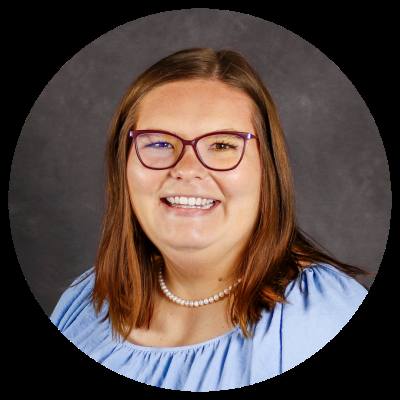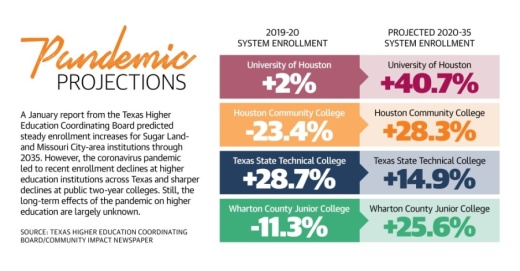Sugar Land- and Missouri City-area higher education officials said they agree there is no one-size-fits-all solution to educating students amid the coronavirus pandemic, which Harrison Keller, Texas Higher Education Coordinating Board commissioner, called “the biggest disruption to higher education” since World War II.
This disruption has caused enrollment to drop statewide by 3.4%; however, both the University of Houston at Sugar Land and Texas State Technical College in Fort Bend County are bucking nationwide enrollment trends for higher education institutions.
Across the nation, nearly 22% fewer students from the graduating class of 2020 immediately enrolled in college after graduation as compared to the class of 2019, according to a report by The National Student Clearinghouse Research Center.
The measurable changes in local enrollment have been accompanied by innovative programing and flexible course offerings necessitated by the COVID-19 pandemic but have come with a social and financial cost.
Monica Lee, a student in her final semester studying software development at Houston Community College, said her program, as with many others at local institutions, was forced to adapt quickly and work through kinks in online learning and safety protocols.
“It was a curveball that we had to kind of overcome,” Lee said. “And I think we pretty much found that not only could every curveball be hit, but they can also be knocked out of the park.”
Enrollment and engagement
Due to expansions at UH at Sugar Land, including recently-added Bauer College of Business courses and new programs at the growing College of Technology, student enrollment was up 25% this spring as compared to a year prior, said Jay Neal, associate vice president and chief operating officer for UH at Sugar Land.
At TSTC’s Fort Bend County campus, student enrollment continued to grow at a slower rate this year—up by about 3% compared to previous 10%-15% growth year over year, said Randall Wooten, TSTC Fort Bend County campus provost.
However, at Houston Community College, end-of-term enrollment was down by 14% as compared to last year, and current spring enrollment is down by 11%, said Kurt Ewen, vice chancellor for strategy, planning and institutional effectiveness at HCC. Among higher education institutions, community colleges have been hit hardest by enrollment slumps, according to national data.
HCC officials attributed these decreases, which Ewen said are worse than what other colleges have seen, to HCC having a higher proportion of lower-income students, many of whom do not have adequate access to technology or Wi-Fi.
At Wharton County Junior College, enrollment numbers have gone down by approximately 12% since the pandemic began, WCJC officials said. While the long semesters saw enrollment decrease, WCJC officials said the school's condensed mini sessions in summer and winter have not seen significant enrollment changes.
While the format in which many college students attend their classes has evolved, TSTC has seen few interruptions to in-person classes during the pandemic, Wooten said. Since the majority of courses at the Fort Bend County campus are hands-on workforce training programs, TSTC brought all students back for in-person courses in early May 2020, save students in the cybersecurity program.
“TSTC has changed very little as far as our offerings, our student body, our growth,” Wooten said. “We’ve changed the way we’ve acted within the laboratory, but ours is just about all good news.”
Obstacles and innovations
HCC and TSTC brought students in workforce training programs back to campus early in the pandemic. Gov. Greg Abbott’s executive order allowing for essential businesses to resume operations cleared the way for the campuses to open, said John Kennedy, a field development officer at TSTC Fort Bend County.
Ewen said it has been hardest to maintain COVID-19 safety protocols, such as social distancing, in some of the hands-on courses. He gave the example of a truck driving course, in which multiple students and a faculty member—all wearing masks and, in many cases, gloves and face shields—may all be in the cab of a truck together.
However, many academic programs continue to be remote. Neal said 20%-25% of classes at the UH at Sugar Land campus are held in person, and each of them now has fewer students due to social distancing protocols. Neal said a classroom that traditionally sits 40 people now fits 15, and the larger lecture halls, which have 180 seats, now can only fit about 32 students.
“When you’re home and your family’s not there, your home is just a house. So when your faculty, your staff, your students are not there, these are just buildings,” Neal said. “It is not the same without our students. I, personally, miss them tremendously.”
With the transition to online classes came a need for additional training for faculty and students. Before the pandemic, Ewen said about half of HCC’s faculty had never taught a course online before.
“We had to do training very quickly of all of our faculty,” WCJC President Betty McCrohan said. “Training for our faculty was critical, and we didn’t have the funds really set aside to do that kind of training.”
The costs associated with equipping classes with personal protective equipment required for in-person classes and upgraded technology necessary for remote instruction were largely offset by the federal Coronavirus Aid, Relief and Economic Security Act, which allocated more than $1.1 billion to Texas higher education. McCrohan said federal assistance, combined with emergency saving funds, was paramount in making up for lost tuition revenue.
“We were losing tuition and fees, so it made it very difficult for us to even balance our budget,” McCrohan said. “We’ve been saving for years for an emergency, and this was just such an emergency.”
Planning for the ‘next normal’
Despite the challenges, programs at each school continued to graduate students on time and help them find employment, leaders from each institution said.
Students in the UH College of Nursing were able to earn hours needed for graduation while working for and earning money at local hospitals. This practice was approved by the national nursing licensing board this summer, and College of Nursing Dean Kathryn Tart said UH was the first nursing program in the state to implement it.
“[The pandemic has] been challenging and forced us to be really innovative,” Tart said. “At the end of the day, our outcomes have been wonderful—students have graduated on time.”
Despite the setbacks, a January report from the Texas Institutions of Higher Education still projected that higher education enrollment in the state will have grown by 13% by 2025. The same report predicted that two-year colleges will play an important role in reskilling and upskilling Texans who have been affected by COVID-19.
Additionally, Fort Bend ISD students have completed the Free Application for Federal Student Aid for the 2021 school year at rates on par with those of previous years. There is a strong correlation between completing the FAFSA and college enrollment, according to the U.S. Department of Education. TSTC, which receives funding from the state of Texas based on the salaries of students five years after graduation, said more than 80% of students who have graduated during the pandemic are employed.
“The industry has not shut down,” Kennedy said. “There’s still a very high demand for students, and I think it will be that way for the foreseeable future, especially since the tide is finally turning on, ‘You have to go to a four-year university.’”
This summer and fall, higher education programs in the area will seek to bring more students back for in-person classes as it becomes safer to do so. Still, Ewen said the efficiency found in holding virtual meetings, as well as some of the convenience more online courses provide students, might lead those practices to be continued for years to come.
WCJC, which held about 85% of its classes online in the fall 2020 semester, said it will continue to expand its in-person options. According to a WCJC student survey, students prefer in-person learning but are also enthusiastic about hybrid offerings.
Neal said his team is already planning for what they are calling the “next normal.”
“It’s exciting—a little stressful, but exciting—to be planning for the future again, where it’s something positive,” Neal said. “The sooner we get the students back face-to-face, everybody’s happy.”





